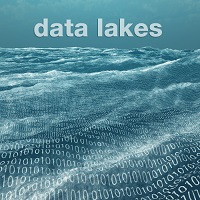INTRODUCTION TO ETL, ELT, AND DATA LAKE
ETL (Extract, Transform, Load) and ELT (Extract, Load, Transform) are two different types of processes to move data from a source system to a destination system. ETL extracts raw data from a source and transforms it into a structured format and then loads it into a destination system. Transformation takes place on a secondary processing server before loading data into a destination system. However, ELT extracts data from the source and loads it directly into a destination system. Transformation takes place in a destination system or a database.
ETL is in practice for over 20 years and is best for small datasets that require complex transformations. It also maintains the privacy and security of data. ELT is newer than ETL and ideal for large datasets that require high speed and efficiency. ELT is compatible with data lakes due to its ability to handle large and unstructured datasets. Selecting the appropriate method depends on factors, such as data volume, speed, privacy concerns, and maintenance costs.
A data lake stores large amounts of structured, semi-structured, and unstructured data. Unlike data warehouses, data lakes’ unrefined data allows data scientists to access all data in its original, raw, and untransformed state. Data lakes’ high scalability and cost-effectiveness on multiple data formats make them an attractive option to store and analyse large amounts of data. With the ability to centralize, consolidate, and catalogue data, data lakes can help to eliminate data silos and to achieve better collaboration and integration of diverse data sources.
UNDERSTANDING THE TRADITIONAL ETL PROCESS
Traditional ETL processes required IT staff, on-premise databases, and lengthy batch processing sessions, which sacrifice data quality as volumes grew. These methods were less suitable for unstructured data which requires interaction from data engineers and developers for each new data source. Moreover, the hardware required for an on-premise data warehouse was costly and difficult to scale and maintain. The increasing volume and variety of data sources made cloud data warehousing a preferred solution whereas traditional ETL processes delayed reporting and analytics. Traditional ETL without cloud-based ETL puts businesses at risk of missed opportunities and lost revenues.
UNDERSTANDING THE MODERN ETL PROCESS
Modern ETL has numerous advantages over traditional ETL. With cloud-based ETL and rapid batch data processing, businesses can scale data operations with enhanced security features. SaaS (Software as a service) allows for backup, encryption, security, and infrastructure issues while moving data to the cloud.
Cloud-deployed ETL products provide speed, scale, savings, and simplicity while maintaining security, governance, and compliance. Modern ETL tools also import and export structured and unstructured data from various sources and can easily integrate on-premises and cloud data warehouses.
Real-time data pipelines ensure business decision-makers have constant and unlimited access to all the data of all the time. Companies can choose to transform data either before or after loading it into a data warehouse. This flexibility enables us to adapt data pipelines to specific needs and achieve high performance, especially for modern data scenarios such as business intelligence, artificial intelligence, and machine learning.
DIFFERENCES BETWEEN ETL AND ELT
- ETL transform data on a secondary processing server before loading it while ELT load and then transform it in the database.
- ETL is slower than ELT due to pre-load transformation, while ELT is faster due to parallel transformation.
- ETL has been used for over two decades while ELT is a newer form of data integration.
- ETL provides more privacy safeguards than ELT due to pre-processing before the loading of data.
- ETL is costly due to separate servers while ELT is cheaper with less data stack.
- ELT is compatible with data lakes whereas ETL is compatible with data warehouses.
- ETL produces structured data output whereas ELT produces structured, semi-structured, and unstructured data output.
- ETL is ideal for small datasets with complicated transformation requirements whereas ELT is ideal for large datasets that require speed and efficiency.
ADVANTAGES OF ELT OVER ETL IN DATA LAKES
- Increase flexibility: ELT loads raw data into the data lake and enables more flexibility in the transformation process.
- Parallel processing: Loading raw data and performing transformations ELT reduces processing time.
- Cost-effective: ELT store raw data, which reduces storage costs, whereas ETL transform and store data before loading it into the data warehouse.
- Improved scalability: ELT can handle large volumes of data.
- Unstructured data: Data lakes handle both structured and unstructured data. ELT handles unstructured data due to flexibility in the transformation.
TOOLS FOR IMPLEMENTING ELT IN DATA LAKES
Hevo Data, Blendo, Matillion, Talend, and StreamSets are top ELT tools that can integrate, clean, and analyse data from various sources. Hevo Data and Blendo are cloud-based platforms, easy to use, and require no coding, making them suitable for users needing more technical expertise. Luigi is an open-source Python framework that can extract data from various sources and load it to a destination. Matillion, Talend, and StreamSets integrate data in real time and make informed decisions based on accurate, up-to-date information.
These ELT tools do processes like data profiling, cleansing, transformation, and governance to improve data quality, reduce errors, and enhance the reliability and accuracy of their data.
FUTURE TRENDS IN ELT AND DATA LAKES
The coexistence of data warehouses and data lakes will converge on both sides expanding into the other’s space. Data lakes will grow with Machine Learning and Artificial Intelligence. Organizations will prioritize TCO (Total Cost of Ownership) optimizations and execute an ROI (Return on Investment) driven approach. Data security and governance will be a top concern with data access controls for effective policy management.
CONCLUSION
The emergence of modern data solutions led development of ELT and ETL with unique features and advantages. ELT is more popular due to its ability to handle large and unstructured datasets like in data lakes. Traditional ETL has evolved into cloud-based ETL which allows rapid batch processing, scalability, savings, and simplicity while maintaining security, governance, and compliance. Modern ETL led development of ELT to make data solutions more flexibility, parallel processing, and cost-effective. The future of ELT and data lakes is promising as organizations prioritize machine learning and artificial intelligence. ELT tools integrate, clean, and analyze data from various sources, will become more advanced and easier to use. As data continues to grow, ELT and data lakes will enable businesses to achieve better integration of diverse data sources, ultimately leading to informed decision-making.
About the Author

Ashutosh Kumar is a student pursuing B.Sc.Ll.B (with data science) from National Forensic Sciences University, Gandhinagar, Gujarat, India. B.Sc.Ll.B is an integrated course of Law with Data Science.
Sign up for the free insideAI News newsletter.
Join us on Twitter: https://twitter.com/InsideBigData1
Join us on LinkedIn: https://www.linkedin.com/company/insidebigdata/
Join us on Facebook: https://www.facebook.com/insideAI NewsNOW





Insightful analysis! Inside Big Data’s exploration of ELT’s preference over ETL in data lakes provides valuable insights for data engineers. Appreciate the perspective!